
Epacris is a genus of about forty species of flowering plants in the family Ericaceae. It was formerly treated in a closely related but separate family Epacridaceae, but the various genera within Epacridaceae including Epacris have been revised in their relationships to each other and brought under the common umbrella of the Ericaceae. The genus Epacris is native to eastern and southeastern Australia, New Caledonia and New Zealand. The species are known as heaths or Australian heaths.
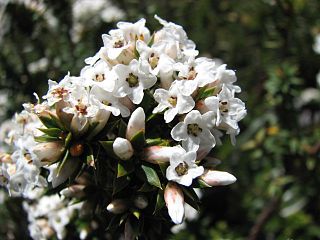
Epacris breviflora, commonly known as drumstick heath, is a plant of the heath family, Ericaceae and is endemic to the south-east of the Australian continent. It is an erect shrub with egg-shaped leaves with a sharp-pointed tip and with clusters of white flowers arranged near the end of the branches. It grows in Victoria, New South Wales and the far south-east of Queensland.
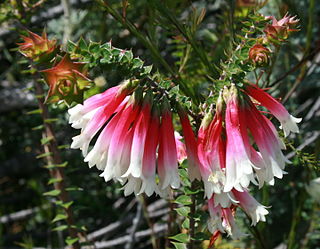
Epacris longiflora, commonly known as fuchsia heath or cigarette flower, is a plant in the family Ericaceae and is endemic to eastern Australia. It is an erect or spreading shrub with egg-shaped, pointed leaves and red tube-shaped flowers which give the plant its name longiflora and are usually present throughout the year. Its native range extends from the central coast of New South Wales to southern Queensland.
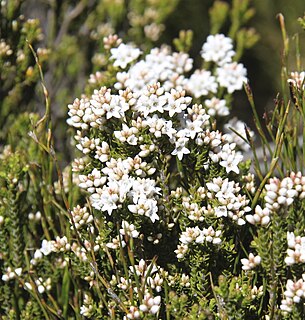
Epacris glacialis, commonly known as reddish bog-heath, is a species of flowering plant in the family Ericaceae and is endemic to south-eastern continental Australia. It is a prostrate to low-lying shrub with crowded, rhombus-shaped to broadly egg-shaped leaves with the narrower end towards the base, and tube-shaped, white flowers in small clusters near the ends of the branches.
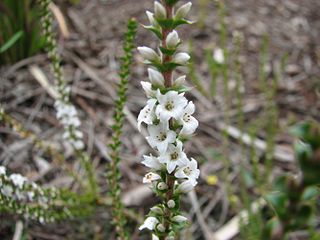
Epacris gunnii is a species of flowering plant in the family Ericaceae and is endemic to south-eastern Australia. It is an erect shrub with hairy branchlets, concave, sharply-pointed, broadly egg-shaped leaves, and tube-shaped, white flowers arranged along the stems.
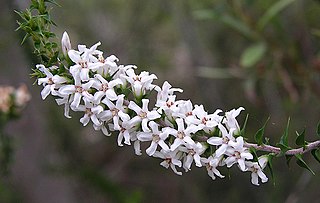
Epacris pulchella, commonly known as wallum heath or coral heath is a species of flowering plant in the family Ericaceae and is endemic to eastern Australia. It is a slender, erect shrub with egg-shaped, pointed leaves and white or pinkish, tube-shaped flowers.

Epacris obtusifolia, commonly known as blunt-leaf heath, is a species of flowering plant from the heath family, Ericaceae, and is endemic to eastern Australia. It is an erect shrub with few stems, crowded, oblong to elliptic leaves and tube-shaped white or cream-coloured flowers arranged along the stems.

Epacris reclinata, commonly known as fuchsia heath, is a species of flowering plant in the family Ericaceae and is endemic to eastern New South Wales. It is a low-lying to spreading shrub with egg-shaped leaves and pink to red, tube-shaped flowers, sometimes with lighter tips.
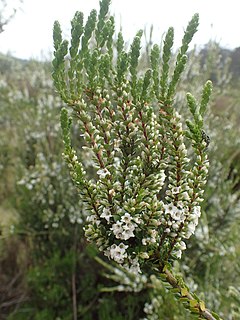
Epacris rhombifolia commonly known as mountain coral heath, is a plant in the heath family Ericaceae and is endemic to eastern Australia. It is an erect, multi-stemmed shrub with broad, rhombic leaves and white flowers with four petals, the flowers spreading down the branches. It only grows in wet, subalpine heath and is sometimes regarded as a variety of Epacris microphylla.

Epacris calvertiana is a plant of the heath family, Ericaceae and is endemic to New South Wales. It is an erect to diffuse shrub with elliptic to egg-shaped leaves with a sharp-pointed tip and with white, pink or red flowers arranged along the ends of leafy branchlets.

Epacris sprengelioides is a species of flowering plant in the family Ericaceae and is endemic to a small area in the Blue Mountains in New South Wales. It is an erect shrub with shaggy-hairy branchlets, more or less erect, narrowly elliptic leaves, and white or cream-coloured, tube-shaped flowers.

Epacris muelleri, commonly known as Mueller's heath, is a species of flowering plant in the heath family Ericaceae and is endemic to eastern New South Wales. It is an erect, or weak straggling shrub with more or less glabrous branchlets, elliptic leaves and white or cream-coloured, tube-shaped flowers.

Epacris browniae is a species of flowering plant in the heath family Ericaceae and is endemic to a small area of New South Wales. It is an erect, woody shrub with wand-like branchlets, crowded, glabrous, trowel-shaped leaves and tube-shaped flowers with white petals.

Epacris crassifolia is a species of flowering plant in the heath family Ericaceae and is endemic to south-eastern New South Wales, Australia. It is a low-lying shrub with elliptic to egg-shaped leaves with the lower end towards the base, and tube-shaped, white or cream-coloured flowers clustered near the ends of the branches.

Pomaderris phylicifolia, commonly known as narrow-leaf pomaderris, is a species of flowering plant in the family Rhamnaceae and is to south-eastern Australia and New Zealand. It is a slender shrub with hairy stems, narrowly egg-shaped to linear leaves, and small clusters of cream-coloured to yellow flowers.
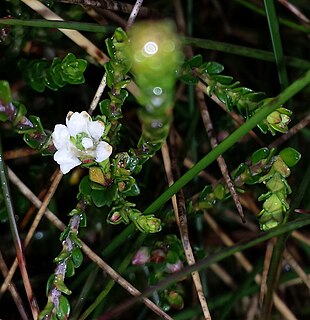
Epacris celata is a species of flowering plant in the heath family Ericaceae and is endemic to south-eastern continental Australia. It is a spreading to erect shrub with flat, elliptic to egg-shaped leaves with the narrower end towards the base, and tube-shaped white flowers clustered in upper leaf axils.

Epacris hamiltonii is a species of flowering plant in the family Ericaceae and is endemic to the Blue Mountains in New South Wales. It is a slender, low-lying to ascending shrub with hairy branchlets, thin, flat, hairy egg-shaped leaves, and white, tube-shaped flowers arranged in small groups at the end of branches.

Epacris paludosa, commonly known as swamp heath, is a species of flowering plant from the heath family, Ericaceae, and is endemic to eastern Australia. It is an erect, bushy shrub with lance-shaped, elliptic or egg-shaped leaves and tube-shaped white or cream-coloured flowers in crowded, leafy heads at the ends of branches.
Epacris rigida is a species of flowering plant in the family Ericaceae and is endemic to eastern New South Wales. It is an erect, bushy shrub with elliptic leaves and white or cream-coloured, tube-shaped flowers.

Epacris rigida is a species of flowering plant in the family Ericaceae and is endemic to south-eastern New South Wales. It is an erect to spreading shrub with egg-shaped to more or less circular leaves and sweetly-scented, cream-coloured, tube-shaped flowers.




















